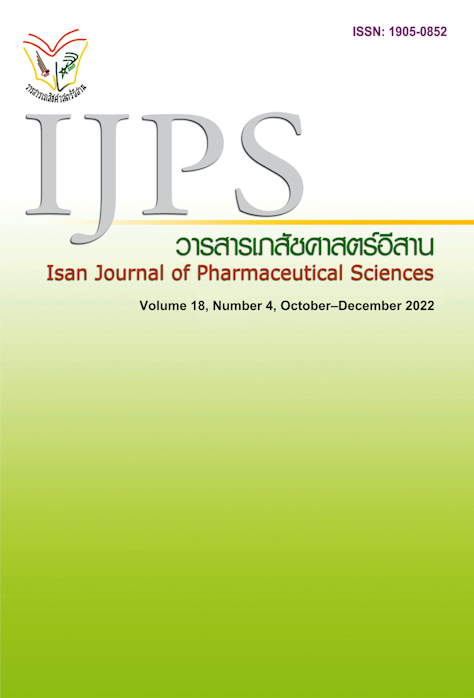A Comparison of Learning Achievement of Online Drug Information Service Training and On-Site Drug Information Service Training for Pharmacy Students
Main Article Content
Abstract
This research aimed to compare how well pharmacy students learned from onsite drug information service training to online drug information service training. Methods: The sample groups consist of sixth-year students from the Faculty of Pharmacy, University of Phayao who participated in training for on-site drug information services in the academic year 2019 (n = 76) and online drug information services in the academic year 2020 (n = 64). Data was collected using the practice record form, the practice's total score, and the number of activities. The mean and standard deviation were the statistics employed in the data analysis, along with a t-test to determine independence. Results: Students who practiced online training on average had higher overall scores than those who practiced on-site training (a full score of 70 points;63.76+4.92 and 59.45+7.78 , respectively; p<0.01). Also, students who practiced online received significantly higher scores on skills and abilities than those who practiced on-site (a full score of 40 points; 36.68+3.05 and 33.95+4.9, respectively; p<0.01). By practicing on-site, it is possible to arrange for all students to practice all activities with the exception of two: reporting adverse drug reactions and drug use evaluation and prevention/corrective activities. Regarding the online practice, there is only one task that each student can complete, which is answering questions or providing drug-related information. Conclusion: The online drug information service training performed better than the on-site drug information service training in terms of both overall scores and skill and ability scores. However, compared to students who practiced online, those who practiced on-site training completed more activities that matched the criteria. This can be because prescribing information and patient case studies are limited. Therefore, to organize online drug information service training, patient case studies and prescribing data are required so that students can practice carrying out all tasks in accordance with the predetermined criteria.
Article Details

This work is licensed under a Creative Commons Attribution-NonCommercial-NoDerivatives 4.0 International License.
In the case that some parts are used by others The author must Confirm that obtaining permission to use some of the original authors. And must attach evidence That the permission has been included
References
Artsub S, Kunkum S, Sitipoomongkol A. Effectiveness of Moodle E-learning for Kinesiology Students (SPSS 217 Sports Information and Illustration). Journal of professional routine to research. 2015;2:81-9.
Banlue S. The suitable model of online learning and teaching for Ubon Ratchathani Rajabhat University. Journal of Roi Et Rajabhat University.2017;11(2):250-60.
Cushnie B, Sakulsuttiwat J, Samaipanit N, Jaruchotikamol A, Pulbutr P. Effectiveness of computer-assisted instruction (CAI) in pharmacology of antipeptic ulcer drugs. Thai Science and Technology Journal 2018;26(6):1029-40.
Duangchan P, Wirasathien L. Effectiveness of e-learning using ATutor in pharmacognosy I and pharmacognosy laboratory I. Thai Pharm Health Sci J 2013;8(1):24-35.
Lalognum N. A development of training package on media online teaching application by hands-on training(hot) model for students teacher of education faculty of Burapa University. 2015[cited 2021 Apr 23]. Available from: http://webopac.lib.buu.ac.th/catalog/BibItem.aspx?BibID=b00250331.
Lean QY, Ming LC, Wong YY, Neoh CF. Validation of online learning in pharmacy education. Pharmacy Education 2018;18(1):135-42.


